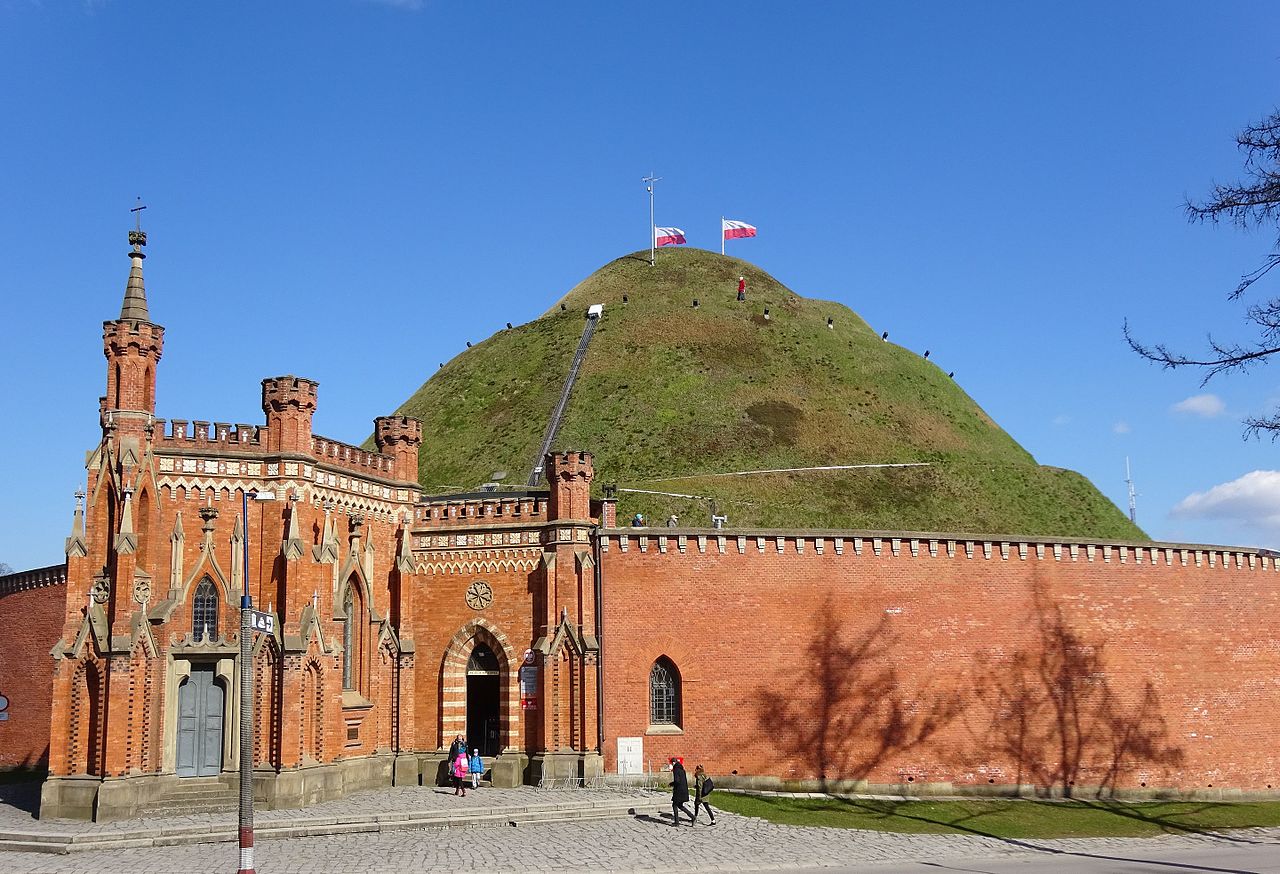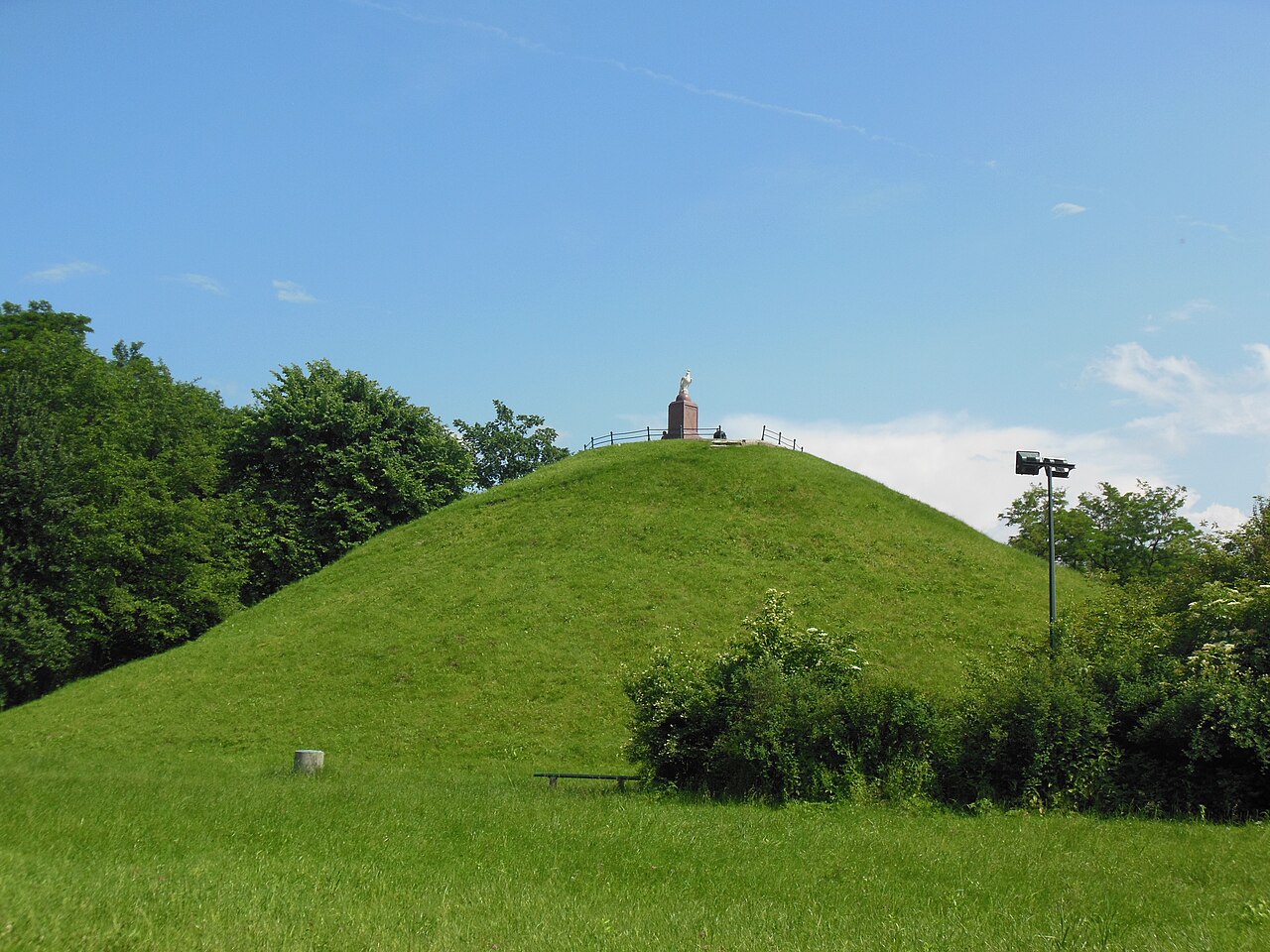 Kopiec Krakusa
Kopiec Krakusa
nazwa: kopiec Krakusa, prastara nazwa: Rękawka,
wiek: około 13 wieków (powstał miedzy VII a IX wiekiem): dowodem jest odnaleziona podczas wykopalisk brązowa ozdoba (skuwka) awarska,
wysokość: 16 m (255 m n.p.m.),
średnice: dolna – 60 m, górna – 8 m,
pojemność bryły: 19100 m³,
budulec: piasek,
jakość: solidna konstrukcja, struktura świadczy o umiejętnym zorganizowaniu transportu przez budowniczych,
osiągnięcia: największy w Polsce, w Europie należy do czołówki, lider wśród przedhistorycznych zabytków Krakowa.
Czym był kopiec Krakusa i kto natchnął ludzi do jego usypania – tego prawdopodobnie się już nie dowiemy. Zamiast odpowiedzi możemy raczyć się domysłami, hipotezami i legendami.
Dziś kopiec Krakusa stanowi najważniejszą atrakcję rekreacyjną Podgórza i jeden z najpiękniejszych punktów widokowych. Najłatwiej dotrzeć do niego od ul. Wielickiej, skręcając za wiaduktem w prawo, w ul. Robotniczą, potem cofając się nieco ul. Lanckorońską do niezbyt szerokich schodków prowadzących ku górze. Potem już każda ścieżka wijąca się od ul. Kopiec Krakusa w górę zaprowadzi do celu. Kopiec sam w sobie jest całkiem przeciętny – ot, kilkunastometrowy pagórek, którego sforsowanie wywołuje zadyszkę. Jednak wiekowa tradycja, tajemnica pochodzenia, no i panorama Krakowa. Roztaczający się stąd widok, poza doznaniami estetycznymi, zapewnia lepszą orientację w mieście. Kopiec jest prawdopodobnie mogiłą Kraka (Krakusa), pradawnego władcy tych ziem i założyciela grodu. Solidność, z jaką usypano ten pagórek, oraz jego wielkość dają pewne wyobrażenie o szacunku i miłości, jakimi lud nadwiślański darzył swego władcę i jak dążył do utrwalenia jego pamięci. Ale nie idealizujmy – mogło być całkiem inaczej. Wykopaliska, które w takich przypadkach stają się najbardziej wiarygodnym źródłem informacji, wykazały, że w bezpośrednim sąsiedztwie kopca natrafiono na ślady osadnictwa z okresu młodszej epoki kamiennej i z końca kultury łużyckiej, pozwoliły też stwierdzić, że kopiec jest młodszy niż znaleziska z wymienionych wyżej epok. Wiadomo również, iż niegdyś na kopcu rósł dąb, ale go ścięto; być może drzewo stanowiące symbol kultu pogan zlikwidowano w związku z chrystianizacją naszych ziem, a w jego miejscu zatknięto brzozowy krzyż.
Wielu pradawnych władców tej ziemi nosiło imię Krak, tak jak legendarny założyciel krakowskiego grodu. Legenda głosi, że wielce szanowanym był Krak IV noszący przydomek Bohater. Panował on w czasach, kiedy składano bogom ofiary, nie szczędząc także ludzi. Ceremoniałowi ofiarowania towarzyszyły tańce, śpiewy, kadzidła i wielkie podniecenie. Pechowców, których wybierano na ofiary, krepowano sznurami i wrzucano w szczeliny skał nad Wisłą. W efekcie końcowym pożerał ich smok. No i właśnie Krak VI wsławił się tym, że zabił smoka (legenda nie precyzuje, czy zrobił to własnoręcznie, czy przy pomocy szewca Skuby), za co wierny lud usypał mu za życia kopiec wdzięczności, dziś nazywany kopcem Krakusa.
Rękawką nazywano kiedyś Kopiec Krakusa (gdyż ci, co go usypali, nosili ziemię w rękawach), ale także radosny odpust przypadający na wtorek po Wielkanocy. Sceną Rękawki, która obok Lajkonika stanowiła najpopularniejszą zabawę masową w Krakowie, był teren od kopca Krakusa po kościółek św. Benedykta. Rozstawiano tam stragany z łakociami i dewocjonaliami, strzelnice, karuzele w kształcie łódek i inne odpustowe atrakcje. Główny sens święta polegał na rzucaniu ze szczytu kopca Krakusa placków, owoców, słodyczy i innego jedzenia, prosto w ręce biedaków i żebraków kłębiących się na dole. W ten sposób nawiązywano do uczty, jaka rzekomo miała miejsce zaraz po usypaniu kopca i w której uczestniczyli jego budowniczowie. Wśród tańców, wróżb, karuzel i innych atrakcji towarzyszących Rękawce, wielkim powodzeniem cieszyły się amatorskie wyczyny sportowe: wspinanie się na szczyt słupa wysmarowanego talkiem oraz wyścigi w workach. Z czasem Rękawka straciła nieco blasku, dalej jednak podtrzymuje się tradycje odpustu, którego korzenie nie dla wszystkich uczestników są oczywiste.
Ze szczytu kopca Krakusa (patrząc na południowy wschód), doskonale widać imponującą paszczę kamieniołomów.
Nieco dalej na południe, za nowym Cmentarzem Podgórskim w obrębie ulic Jerozolimskiej i Abrahama, tam gdzie dziś stoi Pomnik Martyrologii, pięćdziesiąt kilka lat temu rozpoczęto budowę Obozu Koncentracyjnego w Płaszowie.
Obóz koncentracyjny w Płaszowie funkcjonował w latach 1942-1945 jako miejsce masowej eksterminacji Żydów – przede wszystkim – oraz Polaków, Cyganów, Włochów, Węgrów I Rumunów. W szczytowym okresie więziono tu 25 tysięcy ludzi. Słynnym z okrucieństwa i nieobliczalnych czynów komendantem obozu był Amon Leopold Coeth, który z przedwojennego skromnego urzędnika awansował w Płaszowie na pana życia i śmierci tysięcy ludzi. Specjalnie dla niego wybudowano na terenie obozu luksusowa willę z pływalnią i natryskami w ogrodzie. Po wojnie w 1946 r. Najwyższy Trybunał Narodowy skazał go na karę śmierci za ludobójstwo. Wyrok wykonano przez powieszenie.

